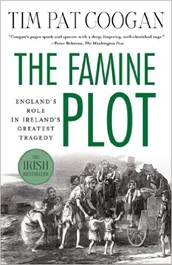
Editor-in-chief: Georges-Claude Guilbert
Book Review Editor: Molly O'Brien Castro
![]()
Tim Pat Coogan, The Famine Plot: England’s Role in Ireland’s Greatest Tragedy (Basingtoke: Palgrave Macmillan, 2012). £9.98 (paperback), 279+i-xi pages, ISBN 1137278838—Stéphanie Prévost, Université Paris Diderot-Paris 7.
Tim Pat Coogan’s The Famine Plot: England’s Role in Ireland’s Greatest Tragedy (2012) was shortlisted in the nonfiction category of 2013 Bord Gáis Energy Irish Book Awards competition, which honours Irish writers across the entire publishing spectrum. Ahead of the online poll, voters, who fall into two categories—a public vote and a specialist Academy vote—, were presented with the following self-description of Tim Pat Coogan’s book. It deserves quoting in full:
In this grand, sweeping narrative, historian Tim Pat Coogan, gives a fresh and comprehensive account of one of the darkest chapters in world history, arguing that Britain was in large part responsible for the extent of the famine, and in fact engineered the food shortage in one of the earliest cases of ethnic cleansing. [‘2013 Shortlist: National Book Tokens Nonfiction Book of the Year’
http://www.irishbookawards.ie/2013-shortlist-natonal-book-tokens-nonfiction-book-of-the-year/
last consulted 1 November, 2015]
Upon the publication of Tim Pat Coogan - A Memoir (Weidenfeld Nicholson, 2008), The Irish Times journalist Conor Brady commented that Coogan was ‘that combination of journalist and historian that, at its best, puts flesh and blood on the bones of dry narrative’ [‘Writing himself into Irish history’, The Irish Times, 11/10/2008]. A long-time editor of The Irish Press (1968-1987), Coogan is famous for his vivid style and his attempts at combining documentary sources with living memories of events, as in The IRA (1970). Some even argue that ‘to many, [Coogan is] the unofficial voice of modern Irish history’ [Prospero, ‘The Irish Famine: Opening Old Wounds’, Blog, 12/12/2012, http://www.economist.com/blogs/prospero/2012/12/irish-famine]. He has widely published on Ireland's nationalist/independence movement in the twentieth century and his biographies of de Valera and Collins proved quite controversial. The Famine Plot: England’s Role in Ireland’s Greatest Tragedy is a blend of these different traits and ranks as popular non-fiction written from an avowedly nationalist perspective. Readers who expect a scholarly study of the Great Irish Famine, which hit Ireland between 1845-1852 killing in between 1-1.5 million Irish and resulting in the emigration of approximately 2 million others at a time when Ireland numbered about 8.1 million inhabitants, will be extremely disconcerted by The Famine Plot, both in terms of historical writing style and argument.
The book totals 278 pages, with 21 pages for six appendices, which include: Trevelyan’s anonymous letters to the Morning Chronicle in 1843, excess mortality rates by county in the years 1846-1851, a county map of Ireland, the Irish Folklore Commission Questionnaire distributed all over Ireland in 1945, the 1948 UN Convention on the Prevention of Genocide, an excerpt from Earl Grey’s speech to the House of Lords on 23 March, 1846 and what is in reality a digest of ‘transactions of the Central Relief Committee of the Society of Friends during the Famine in Ireland in 1846 and 1847’ (rather than the document itself). The Famine Plot is also enriched with 8 illustrated pages, devoted to portraits of major British decision-makers (especially Prime Ministers Peel and Russell, as well as assistant-secretary to the Treasury, Sir Charles Trevelyan) and of Irish nationalists (Daniel O’Connell and John Mitchel), as well as to reproductions of Illustrated London News engravings. What is striking at first is that the sources of documents are never really given in full and as already remarked, appendix 6 passes off as an authentic contemporary document whereas it is only a digest of the information it contains. Unfortunately, the same applies to quotes, which are not always attributed and when they are, are never fully attributed. Page references are indeed systematically missing in the ‘notes’ section, which makes it very inconvenient for readers to retrieve original sources. Besides, Peter Gray’s Famine, Land and Politics: British Government and Irish Society, 1843-1850 (1999) appears in the ‘notes’ section several times, but is omitted from the final bibliography. The title of John Mitchel’s 1860 The Last Conquest of Ireland (Perhaps) is also misquoted once and so is its most famous line, which is rendered on p. 174 as ‘God sent the blight, but the British created the Famine’, instead of: ‘The Almighty, indeed, sent the potato blight, but the English created the famine’ [Glasgow, 1882, 219]. Several factual errors are to be found, starting with the date the Peel government resigned in 1846, which is wrongly given as 9 June in the chronology at the onset of the book [x]. The tithe war ended in 1838, not in 1836 [155]. These might have been minor faults did the overall study present a consistent, thoroughly substantiated argument throughout. Unfortunately, this is not the case.
What Coogan intends to demonstrate is somehow hazy in the introduction although he criticises those who ‘shy away from the apportionment of blame’ [6], suggesting that the book hinges on issues of the British government’s responsibility and guilt. Obviously readers get hints throughout the book—with for instance, Trevelyan being likened to Hitler [166]—, but it is only in the conclusion to the last chapter that Coogan’s indictment of Russell’s two Whig governments (1846-1851) is forcefully made explicit:
Certainly in the years 1846-1851 responsible Whig decision makers were complicit in genocide and did direct public incitement, as the columns of The Times sadly confirm only too well, toward furthering that end. Just as there are those who will sadly attempt to deny man’s role in global warming, there are those who will still attempt to defend the Whigs’ role on the grounds that the UN Convention on Genocide stems from 1948, not 1848. To them I end by saying that there is another, even older command on which the UN declaration draws, and it is not disputed: Thou shall not kill. [231]
By postponing the direct accusation to the very last pages of the book, readers expecting a scholarly study will feel puzzled what the book is really about at first and around what new elements the study revolves, all the more so as the ‘plot’ mentioned the title is nowhere to be found really. Surely, Coogan gives examples of the Whig government’s short-sightedness in devising relief policies in Ireland, but fails to document a scheme that aimed at ‘the extirpation of the Irish as a race’—to take up Cormac O’Grada formula in Ireland Before and After the Famine: Explorations in Economic History, 1800-1925 [Manchester, MUP, 1988, 122]. Not only is there no convincing trace of the British State’s intent, which the term ‘genocide’ precisely entails, but Coogan makes no attempt either at distinguishing between ‘active’ and ‘passive genocide’, which his argument would require.
Coogan satisfies himself with setting the tone in the introduction by reminding readers that renowned historian of contemporary Germany, A.J.P. Taylor, had been convinced by Cecil Woodham-Smith’s 1962 The Great Hunger that ‘all Ireland was a Belsen’ at the time of the Famine [3]. Coogan is aware of the past criticisms levelled at Taylor, but also at Woodham-Smith whose 1962 study gave rise to an essay question submitted to history students at Trinity College, Dublin in 1963 that denied The Great Hunger its scholarly status (‘The Great Hunger is a great novel. Discuss.’) He thus anticipates that similar criticisms would be made against his Famine Plot, which belongs to the same tradition, and accuses Irish historians of ‘colonial cringe’ [8] that prevented them from duly apportioning blame:
Most Irish historians would argue that Taylor exaggerated, but the honest anger of a fair-minded Englishman, who incidentally was reviewing the work of an equally fair-minded Englishwoman, The Great Hunger by Cecil Woodham-Smith, when he made the comparison, is preferable to the type of “colonial cringe” with which too many Irish historians have approached the topic. [3]
From this, readers can guess what The Famine Plot will read like: Coogan’s attempt to rectify what he assumes has been the error of Irish historians of the Great Famine, whom he finds too complacent with the main official reading at the time that it was inevitable, Malthusian and God-willed. Throughout The Famine Plot, Coogan settles scores with historians—Irish historians in particular who ‘as a class have not done justice to the Famine’ [4]—, but he fails to retrace the historiography of the Great Famine, which entered its third phase with post-revisionism in the late 1980s/early 1990s. Coogan’s omitting the publication dates of books that he lists in the book itself (whereas they appear in the notes) also contributes to (the impression of) his negating recent historiographical developments. Although he does mention historians from the post-revisionist phase (James Donnelly, Peter Gray, Christine Kinealy, Joel Mokyr, Cormac Ó’Gráda, etc.), he still overall blames them for ‘the unacknowledged portion of the legacy’. And yet, several of them, not least Cormac Ó’Gráda and Christine Kinealy, both of them Irish historians, criticised revisionism and called for the need to re-examine the history of the Great Famine in the late 1980s-early 1990s. With this in mind, Coogan’s The Famine Plot reads all the more dated in terms of rhetorical argument, not to say flawed. He desperately seeks to rekindle the flame of the ‘die-hard’ nationalist narrative of the Great Famine, which seems long superseded, amongst academics at least.
As a popular historian writing in the Mitchelian vein, Coogan tries to bridge what he identifies as an ‘affective gap in existing historiography’, to borrow Margaret Kelleher’s phrase from her 2013 ‘Memory Studies and Famine Studies: Gender, Genealogy, History’ [The Irish Memory Studies, UCD, Series 8, 3]. The oversimplification and even distortion of the historiography serve this purpose: in a dual move, this probably prevents Coogan from referring to the work of Irish historian of the Famine, Niall Ó Ciosain—especially to his 1996 Irish Studies Review article ‘Was there 'Silence' about the Famine?’—, as well as leads him to minimise contributions by other Irish specialists of the Great Famine inscribing themselves in the post-revisionist phase, especially economic historian Cormac Ó’Gráda and radio producer at RTE Cathal Póirtéir, while still including their works in his bibliography. Coogan tries to bring to life the suffering of the Irish at the time of the Famine by all means. This includes quotes from a wide array of contemporary sources—which are mostly correctly quoted, although not properly attributed—, but also sensationalist chapter titles—see for instance Chapter 4: ‘Five Actors and the Orchards of Hell‘—and many dubious comparisons: first, Trevelyan is likened to Hitler [166]; and then, the tragic lot of the Willises from Limerick to Canada, which saw the death of several members of the family during the transatlantic passage, is made the responsibility of the British State by evoking Sophie’s choice in William Styron’s 1979 highly controversial, pseudo-factual Auschwitz novel [211]. Strong emotive language is meant to allow Coogan to reach out to the Irish, with whom the Famine still resonates both in Ireland and in places where ancestors emigrated to try their luck elsewhere, and beyond. This is a rhetorical, populist strategy that Coogan is familiar with, as Mick Heaney’s Irish Times review of the January 2013 RTE programme devoted to the Great Famine (‘the Blighted Nation series’) reminds us (‘Facing the Famine’, 5/1/2015, http://www.irishtimes.com/culture/tv-radio-web/facing-the-famine-a-testy-topic-that-stood-out-among-the-fluff-1.954700). And yet, there is no need for blackening, as what happened during the Great Famine is appalling enough: not only has now the historical consensus established that ‘the Great Famine was the defining event of nineteenth-century Irish history’ [Ó’Gráda, 'Introduction' in Ó’Gráda (ed.), Ireland’s Great Hunger: Interdisciplinary Perspectives, Dublin, University College Dublin Press, 2006, 1], but also that it was ‘the last European subsistence crisis’ [R. Paping, E. Vanhaute, C. Ó’Gráda, When the Potato Failed: Causes and Effects of the Last European Subsistence Crisis, 1845-1850, Turnhout, Brepols, 2007]. The genocide theory Coogan upholds has however been discarded, most notably by Ó’Gráda in his 1988 Ireland Before and After the Famine: Explorations in Economic History, 1800-1925 [132]:
The current orthodoxy (…) tends to view the Great Famine as both unavoidable and inevitable. I see it as the tragic outcome of three factors: an ecological accident that could not have been predicted, and ideology ill geared to saving lives and, of course, mass poverty. The role of sheer bad luck is important: Ireland’s ability to cope with a potato failure would have been far greater a few decades later, and the political will— and the political pressure—to spend more money to save lives greater too. If this postrevisionist interpretation of events of the 1840s comes closer to the traditional story, it also keeps its distance from the wilder populist interpretations mentioned earlier. Food availability was a problem; nobody wanted the extirpation of the Irish as a race.
Upon a close reading of The Famine Plot, another thread underpins the book: that the Irish have recurrently been failed by their governments. This populist stance, which calls for open contest, is mostly directed at Irish political parties today. Indeed if one can agree with Coogan that ‘the legacy of the Famine, both acknowledged and unacknowledged, has resonances for today’s Ireland’ [1], his apportioning similar blame to the British governments’ for their handling of the Great Famine, to the Fianna Fail Party for their handling of the late 2000s economic crisis, as well as to Fine Gael for their failure to represent the British State at the time of the Famine as a colonial enemy government – whereas at the same time, in 1997, Tony Blair admitted that ‘those who governed in London at the time failed their people’ [8]—is highly problematic. In seeking to speak for the people—and Coogan praises taxi driver Michael Blanch and song-writer Pete St John for having done more for Famine history than Irish historians themselves [8]—, Coogan adopts an anti-government, anti-academia stance.
Thus, readers looking for a scholarly study of the Great Famine cannot but feel disaappointment, especially as some points—such as the prevalence of the Divine interpretation of the blight over scientific explanations, the charitable records of Quakers [139] or souperism [149]—are rather precisely rendered, while others are clearly not historical. But then, The Famine Plot is intended as popular history. Coogan’s combat for righting the wrongs encourages him to produce a binary rhetoric of ‘we’ (the Irish people) versus ‘they’ (the British government, and especially that of Lord John Russell). All that would complexify that pattern is carefully, though uneasily shunned. This applies to the rift between Old and Young Ireland, which is glossed over: ‘This is not the place for going into a detailed digression on the Young Irelanders, their policies and their differences with O’Connell, which eventually led them along the road to insurrection.’ [185] It follows that there is no mention of the creation of the Irish Confederation in January 1847, nor of the General Election that occurred a few months later and saw ‘Repeal in retreat’ amongst Irish MPs, including John O’Connell, the ‘Liberator’s son [C. Kinealy, Repeal and Revolution, 2009, Manchester, MUP, 89]. Eschewing the secession between Old and Young Ireland in the wake of the July 1846 ‘peace resolutions’ and even more neatly in the context of Daniel O’Connell’s death in May 1847 allows Coogan to construct an unproblematic, unbroken lineage between Old and Young Ireland, between O’Connell and Mitchel, that does away with the rife debate on strategies and the opposition between ‘moral force’ and ‘physical force’. This is only one of many examples. Suffice to say here that although Coogan concedes that ideology did frame the British State’s responses to the Famine—through a reference to Trevelyan’s ‘language of morality’ [97]—and even fragmented the Whig minority governments of Russell [99], he fails to fully take the cue from historian Peter Gray that ‘contextualization was vital’ ‘to unravel and interpret a specific dimension of the crisis: the response of British government and public opinion to the disaster in the light of contemporary debates about the nature and future of Irish society’ [Land, Famine and Politics: British Government and Irish Society, 1843-1850, Dublin, Irish Academic Press, 1999, vii]. A historical analysis of the role of the 1851 census of Ireland, as he mentioned 1851 census death figures [11], would have allowed Coogan to pin down the primacy of ideology and perhaps would have made possible a more nuanced, a more contextualised appraisal of both Peel’s record during the Famine—instead of quasi-hagiography [105]—and more largely of British politics / policies at the time of the Great Famine.
But definitely, Coogan’s objective with The Famine Plot is not so much about carefully transcribing past events as to root the Great Famine at the core of Irish history today. This is what the last line of the book suggests: ‘A land that could survive the Famine can survive almost anything.’ [235] The Famine Plot does not offer original research, but is a 21st-century Mitchellian narrative perpetuating the genocide theory. It has thus sparked off a vivid controversy that the December 2012 radio debate between Liam Kennedy and Tim Pat Coogan as part of the BBC Northern Ireland’s Sunday Sequence Programme broke out to the public (http://www.drb.ie/blog/writers-and-artists/2013/02/25/was-the-famine-a-genocide). Readers who abide by French historian Michel de Certeau’s rule that ‘the writing of history can only begin when a present is divided from a past’ [Tom Conley’s introduction to Michel De Certeau’s The Writing of History, New York, Columbia UP, 1988, viii] will certainly question the book’s status as (serious) history, but perhaps the merit of The Famine Plot lies elsewhere… In perpetuating the genocide theory, Coogan paradoxically reasserts the need for further historical knowledge about this tragic episode in Irish history and its dissemination beyond the mere realm of academia. This is a purpose that the Quinnipiac Great Hunger Museum directed by Irish historian Christine Kinealy set itself when it opened in 2012 [‘Introduction to the Museum’, Ireland Great’s Hunger Museum website,
http://ighm.nfshost.com/about/museum-history, last consulted 2/12/2015], but by contrast to Coogan, the Quinnipiac Great Hunger Museum research staff have decided to pursue the track of a more disinterested inquiry…
©
2016 Stéphanie Prévost & GRAAT

Senior
sub-editor: Hélène Tison
lntison@yahoo.fr
Webmaster: Georges-Claude Guilbert

